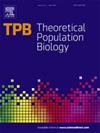孤雌生殖、性冲突和选择对转换环境中受精率的影响。
IF 1.3
4区 生物学
Q4 ECOLOGY
引用次数: 0
摘要
面对变化的环境,生物表现出各种各样的生殖模式,从无性到专一性。如果生殖是有性的,这些生物产生的性细胞(配子)的形态具有重要的进化意义;这些细胞可以大小相同(同卵异体),一个大一个小(异卵异体),最后较大的细胞失去运动能力(卵异体,我们熟悉的精子-卵子系统)。了解性别的起源,这取决于它们产生的配子的类型,从而可以解释这些进化转变。在这里,我们通过探索生物可以有性繁殖和无性繁殖的模式中的这些转变,扩展了这一领域的经典结果。这种繁殖模式存在于许多藻类中,并伴随着雌性褐藻丝虹吸的信息素产生受到抑制。我们的模型研究了配子细胞大小与受精率的共同进化,受精率是运动和信息素产生的代理,但在异配模型中通常保持不变。将自适应动力学推广到切换环境的情况下,我们发现同种异体可以通过进化分支进化到异配异体,而异配异体可以通过性别冲突驱动的进一步分支进化到卵配异体或抑制信息素的产生。我们还推导出了在这条等配-卵配轨迹上停止进化所需的模型参数的解析条件,即在下注-对冲策略下,低受精率和随机切换环境稳定了等配,低受精成本稳定了异配和信息素的产生。本文章由计算机程序翻译,如有差异,请以英文原文为准。

Parthenogenesis, sexual conflict, and selection on fertilization rates in switching environments
In the face of varying environments, organisms exhibit a variety of reproductive modes, from asexuality to obligate sexuality. Should reproduction be sexual, the morphology of the sex cells (gametes) produced by these organisms has important evolutionary implications; these cells can be the same size (isogamy), one larger and one smaller (anisogamy), and finally the larger cell can lose its capacity for motility (oogamy, the familiar sperm–egg system). Understanding the origin of the sexes, which lies in the types of gametes they produce, thus amounts to explaining these evolutionary transitions. Here we extend classic results in this area by exploring these transitions in a model in which organisms can reproduce both sexually and asexually. This reproductive mode is present in many algae and is accompanied by suppressed pheromone production in female populations of the brown alga Scytosiphon lomentaria. Our model investigates the co-evolution of gamete cell size with fertilization rate, which is a proxy for motility and pheromone production but is often held constant in anisogamy models. Using adaptive dynamics generalized to the case of switching environments, we find that isogamy can evolve to anisogamy through evolutionary branching, and that anisogamy can evolve to oogamy or suppressed pheromone production through a further branching driven by sexual conflict. We also derive analytic conditions on the model parameters required to arrest evolution on this isogamy–oogamy trajectory, with low fertilization rates and stochastically switching environments stabilizing isogamy under a bet-hedging strategy, and low fertilization costs stabilizing anisogamy and pheromone production.
求助全文
通过发布文献求助,成功后即可免费获取论文全文。
去求助
来源期刊

Theoretical Population Biology
生物-进化生物学
CiteScore
2.50
自引率
14.30%
发文量
43
审稿时长
6-12 weeks
期刊介绍:
An interdisciplinary journal, Theoretical Population Biology presents articles on theoretical aspects of the biology of populations, particularly in the areas of demography, ecology, epidemiology, evolution, and genetics. Emphasis is on the development of mathematical theory and models that enhance the understanding of biological phenomena.
Articles highlight the motivation and significance of the work for advancing progress in biology, relying on a substantial mathematical effort to obtain biological insight. The journal also presents empirical results and computational and statistical methods directly impinging on theoretical problems in population biology.
 求助内容:
求助内容: 应助结果提醒方式:
应助结果提醒方式:


